Fiches poissons (page 43)
Page 43 des 2657 espèces de Poissons avec 60 fiches. Il y a 26 genres différents de Trachinotus à Ucla.
Liste des fiches de Trachinotus blochii à Ucla xenogrammus
- Trachinotus blochii
 Pompaneau lune
Pompaneau lune
40,0 → 110,0 cm (> 6000 L)
pH 8,0–8,5 | GH | 0–0°C - Trachinotus ovatus
 Liche glauque, Palomine
Liche glauque, Palomine
35,0 → 70,0 cm (> L)
pH 8,0–8,5 | GH | 23–28°C - Trachycorystes trachycorystes
 Poisson-chat noir
Poisson-chat noir
30,0 → 35,0 cm (> 450 L)
pH 5,0–6,5 | GH 5–15 | 23–29°C - Tramitichromis brevis

14,0 → 16,3 cm (> 450 L)
pH 7,5–8,5 | GH 10–20 | 22–26°C - Tramitichromis intermedius

14,0 → 16,0 cm (> 450 L)
pH 7,5–8,5 | GH 10–20 | 22–26°C - Tramitichromis lituris

14,0 → 17,0 cm (> 450 L)
pH 7,5–8,5 | GH 10–20 | 22–26°C
- Transancistrus santarosensis

4,0 → 7,5 cm (> 120 L)
pH 6,0–8,0 | GH 3–20 | 19–25°C - Trematochromis benthicola
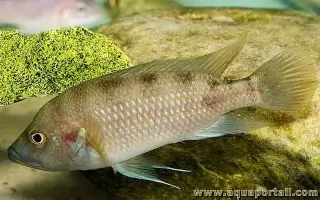
18,0 → 23,0 cm (> 450 L)
pH 7,5–8,5 | GH 10–20 | 23–26°C - Triaenodon obesus
 Requin-corail à pointes blanches
Requin-corail à pointes blanches
150,0 → 210,0 cm - Triakis scyllium
 Requin-chien à bandes
Requin-chien à bandes
90,0 → 150,0 cm - Trichogaster chuna
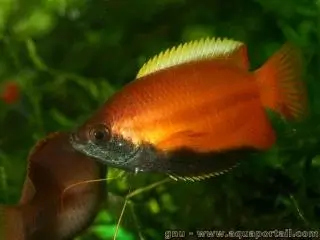 Gourami miel, Colisa chuna, Colisa sota
Gourami miel, Colisa chuna, Colisa sota
3,5 → 4,5 cm (> 50 L)
pH 6,0–7,5 | GH 3–10 | 22–28°C - Trichogaster fasciata
 Gourami bariolé, Colisa fasciata
Gourami bariolé, Colisa fasciata
8,0 → 12,0 cm (> 120 L)
pH 6,0–7,5 | GH 3–10 | 23–29°C - Trichogaster labiosa
 Gourami à grosses lèvres
Gourami à grosses lèvres
8,0 → 10,0 cm (> 120 L)
pH 6,0–7,5 | GH 2–10 | 22–28°C - Trichogaster lalius
 Gourami nain, Colisa lalia
Gourami nain, Colisa lalia
4,0 → 5,0 cm (> 80 L)
pH 6,5–7,0 | GH 1–10 | 15–28°C - Trichopodus cantoris

10,0 → 11,0 cm (> 200 L)
pH 6,0–7,5 | GH 3–10 | 24–27°C - Trichopodus leerii
 Gourami perlé
Gourami perlé
9,0 → 12,0 cm (> 200 L)
pH 5,5–7,5 | GH 1–20 | 23–30°C - Trichopodus microlepis
 Gourami clair de lune
Gourami clair de lune
11,0 → 13,0 cm (> 200 L)
pH 6,0–7,0 | GH 2–20 | 26–30°C - Trichopodus pectoralis
 Gourami peau de serpent
Gourami peau de serpent
18,0 → 25,0 cm (> 450 L)
pH 6,0–8,0 | GH 3–30 | 23–28°C - Trichopodus poptae

6,0 → 7,0 cm (> 200 L)
pH 6,0–7,5 | GH 1–8 | 23–27°C - Trichopodus trichopterus
 Gourami bleu à trois points
Gourami bleu à trois points
12,0 → 15,0 cm (> 200 L)
pH 5,0–8,5 | GH 1–30 | 24–30°C - Trichopsis pumila
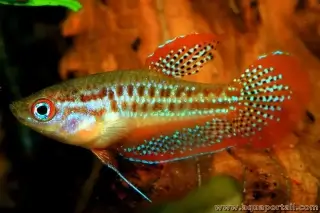 Gourami grogneur nain
Gourami grogneur nain
3,5 → 4,0 cm (> 50 L)
pH 6,0–7,0 | GH 5–15 | 25–28°C - Trichopsis schalleri
 Gourami grogneur de Schaller
Gourami grogneur de Schaller
5,0 → 5,5 cm (> 80 L)
pH 6,0–7,0 | GH 5–10 | 22–28°C - Trichopsis vittata
 Gourami grogneur
Gourami grogneur
4,0 → 7,0 cm (> 80 L)
pH 6,0–8,0 | GH 3–20 | 21–29°C - Trichromis salvini
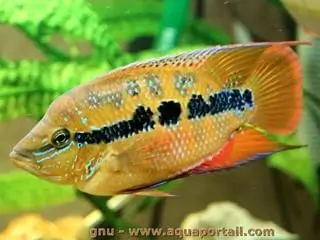 Cichlasoma salvini
Cichlasoma salvini
18,0 → 22,0 cm (> 450 L)
pH 7,0–8,5 | GH 10–30 | 22–32°C
- Trigonopoma gracile

4,5 → 5,5 cm (> 80 L)
pH 6,0–7,0 | GH 5–12 | 22–24°C - Trigonopoma pauciperforatum
 Rasbora à raie rouge
Rasbora à raie rouge
5,0 → 7,0 cm (> 80 L)
pH 5,0–6,5 | GH 3–12 | 22–26°C - Trigonostigma espei
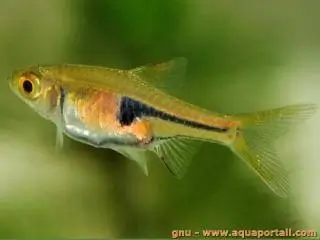 Rasbora de Lambchop
Rasbora de Lambchop
2,5 → 3,0 cm (> 50 L)
pH 6,0–7,0 | GH 1–12 | 23–28°C - Trigonostigma hengeli
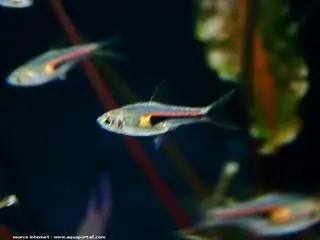 Rasbora de Hengel
Rasbora de Hengel
2,8 → 3,2 cm (> 50 L)
pH 5,0–7,0 | GH 1–8 | 23–28°C - Trigonostigma heteromorpha
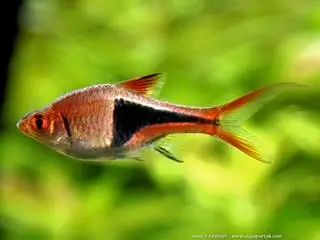 Rasbora arlequin
Rasbora arlequin
3,0 → 4,5 cm (> 80 L)
pH 5,5–7,0 | GH 1–5 | 23–27°C - Trigonostigma somphongsi
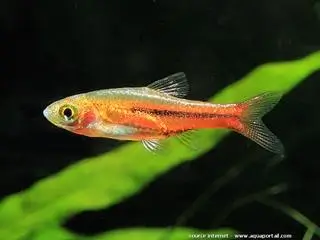
8,0 → 11,0 cm (> 200 L)
pH 6,0–6,5 | GH 5–12 | 22–26°C - Trimma annosum

2,0 → 2,5 cm (> 50 L)
pH 8,0–8,5 | GH | 23–28°C - Trimma benjamini

2,5 → 3,0 cm (> 50 L)
pH 8,0–8,5 | GH | 23–28°C - Trimma cana
 Gobie à rayures rouges
Gobie à rayures rouges
2,2 → 2,5 cm (> 50 L)
pH 8,0–8,5 | GH | 23–28°C - Trimma rubromaculatus
 Gobie rouge
Gobie rouge
3,0 → 3,7 cm (> 50 L)
pH 8,0–8,5 | GH | 23–28°C - Trimma sheppardi
 Gobie nain de Sheppard
Gobie nain de Sheppard
1,5 → 1,9 cm (> 50 L)
pH 8,0–8,5 | GH | 23–28°C - Trimma taylori
 Gobie nain de Taylor
Gobie nain de Taylor
3,0 → 3,5 cm (> 50 L)
pH 8,0–8,5 | GH | 23–28°C - Trimma tevegae
 Gobie des grottes à raie bleue
Gobie des grottes à raie bleue
3,5 → 4,5 cm (> 50 L)
pH 8,0–8,5 | GH | 23–28°C - Trinectes maculatus
 Sole d'eau douce américaine
Sole d'eau douce américaine
11,0 → 18,0 cm (> 300 L)
pH 6,5–8,0 | GH 8–30 | 23–27°C - Tripterygion delaisi
 Triptérygion jaune
Triptérygion jaune
6,0 → 9,0 cm (> 120 L)
pH | GH | 12–22°C - Tripterygion tartessicum

6,0 → 7,7 cm (> 120 L)
pH | GH | 15–24°C - Tripterygion tripteronotum
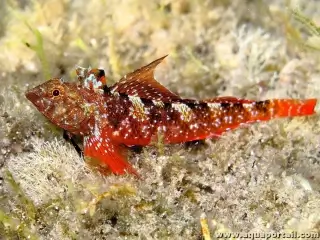
6,0 → 8,0 cm (> 80 L)
pH | GH | 12–24°C - Trochilocharax ornatus
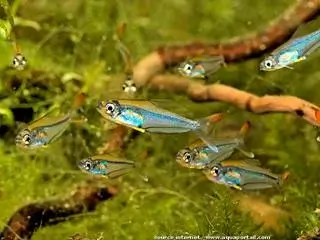 Tétra cristal arc-en-ciel
Tétra cristal arc-en-ciel
1,5 → 1,8 cm (> 20 L)
pH 5,5–7,0 | GH 1–10 | 23–26°C - Tropheops tropheops

12,0 → 15,0 cm (> 300 L)
pH 7,5–8,5 | GH 10–25 | 24–26°C - Tropheus brichardi

9,0 → 11,0 cm (> 450 L)
pH 7,5–8,5 | GH 10–20 | 23–26°C - Tropheus duboisi

9,0 → 12,0 cm (> 300 L)
pH 8,0–9,0 | GH 10–20 | 24–26°C - Tropheus moorii

12,0 → 15,0 cm (> 450 L)
pH 7,5–8,5 | GH 10–20 | 23–26°C - Tropheus polli
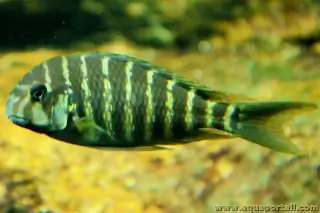
14,0 → 17,0 cm (> 800 L)
pH 7,5–8,5 | GH 10–20 | 23–26°C - Tuberoschistura arakanensis
 Loche naine rosée
Loche naine rosée
3,0 → 4,0 cm (> 50 L)
pH 6,5–8,0 | GH 8– | 20–28°C - Tucanoichthys tucano

1,4 → 1,7 cm (> 20 L)
pH 5,5–7,0 | GH 1–10 | 23–27°C - Tyrannochromis macrostoma
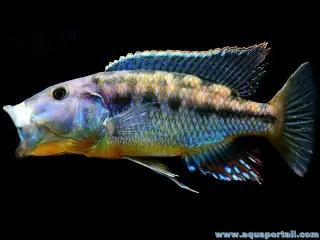
26,0 → 34,0 cm (> 1500 L)
pH 7,5–8,5 | GH 10–20 | 22–26°C - Tyrannochromis maculiceps

24,0 → 32,0 cm (> 1500 L)
pH 7,5–8,5 | GH 10–20 | 22–26°C - Tyrannochromis nigriventer
 Cichlidé tyran
Cichlidé tyran
25,0 → 35,0 cm (> 1500 L)
pH 7,5–8,5 | GH 10–20 | 24–26°C - Tyttobrycon marajoara
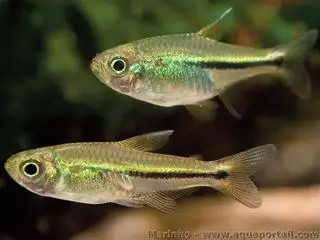
1,0 → 2,0 cm (> 50 L)
pH 5,5–6,5 | GH 1–5 | 23–28°C - Tyttocharax cochui

2,0 → 2,3 cm (> 50 L)
pH 5,5–7,0 | GH 1–8 | 23–26°C - Tyttocharax madeirae

1,5 → 2,0 cm (> 50 L)
pH 5,5–7,0 | GH 1–5 | 23–28°C - Tyttocharax metae

1,6 → 2,1 cm (> 50 L)
pH 6,5–7,5 | GH 3–10 | 23–27°C - Tyttocharax tambopatensis
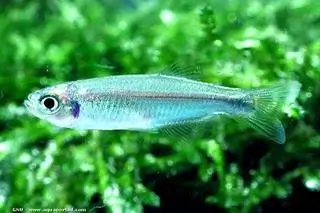 Néon nain
Néon nain
1,4 → 1,8 cm (> 50 L)
pH 5,0–7,5 | GH 1–10 | 20–29°C - Uaru amphiacanthoides

25,0 → 28,0 cm (> 450 L)
pH 5,0–6,5 | GH 1–8 | 26–30°C - Uaru fernandezyepezi

18,0 → 24,0 cm (> 450 L)
pH 5,0–6,0 | GH 1–5 | 28–34°C - Ucla xenogrammus
 Triptérygion à grande bouche
Triptérygion à grande bouche
3,5 → 4,7 cm (> 50 L)
pH | GH | 25–29°C
Les données biologiques des espèces indiquent la taille en cm et, si les valeurs sont pertinentes, d'autres caractéristiques spécifiques.
